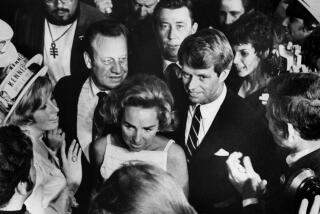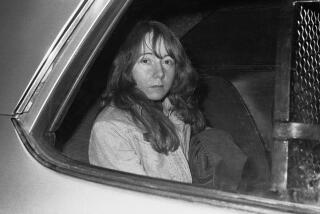In death and in life, TV fixated on JFK
As this year’s death-obsessed Emmy Awards broadcast took time to mention, Nov. 22 will mark 50 years since the assassination of President John F. Kennedy. The remembrance traveled from Walter Cronkite’s announcement of the president’s death to a Carrie Underwood cover of the Beatles’ “Yesterday” to commemorate the band’s 1964 debut on “The Ed Sullivan Show” — “two emotionally charged events, forever linked in our memories,” said segment narrator Don Cheadle, who was born after both of them.
The assassination “was the moment when the television generation came of age,” said Cheadle.
It’s a statement that sounds meaningful without actually saying much. (Television generation? Came of age?) But the death of JFK was certainly the first traumatic national event the medium was called upon to make sense of, to put into order and carry to the people — the first major testing of the national mettle since the Second World War, which had been brought home by print, in newsreels and over the radio. From that moment, it seemed as if anything could happen, at any time, and television news developed to accommodate that theory, into a round-the-clock enterprise lately enlarged (and in some ways diminished) by an auxiliary army of smartphones and Twitter feeds.
A change was already in the air. Only a couple of months earlier CBS had inaugurated the first half-hour evening network newscast, with a Walter Cronkite-Kennedy interview, followed a week later by NBC, with the tag team of Chet Huntley and David Brinkley also speaking with the president. But what strikes one, looking back at the assassination coverage — there are hours of it to see online — is how primitive it all looks.
Young — still the youngest person to have been elected president — and handsome and preternaturally at ease before a camera, Kennedy was the first television president; the third, after Truman and Eisenhower, to serve since the medium really opened for business, but the first to really live in it. He and the medium were made for each other; it was the killer app of its time, and he used it, smartly and in a new way, to campaign, to pitch policy and to make the public his friend.
Writing in TV Guide in 1959, Kennedy described “a new breed of candidates” with “particular reliance on TV appeal.” Given the subsequent entwined history of television and politics, his words ring as prescient (and a little optimistic): “Honesty, vigor, compassion, intelligence — the presence or lack of these and other qualities make up what is called the candidate’s ‘image’ … and while they may in fact be based only on a candidate’s TV impression, ignoring his record, views and other appearances — my own conviction is that these images or impressions are likely to be uncannily correct.”
He knew he had it too, a charismatic mix of patrician, politician and semi-regular Joe. Media theorist Marshall McLuhan, writing about TV’s first presidential debates, described Kennedy as a “shy young sheriff” in opposition to Richard Nixon’s “railway lawyer.” Kennedy, he later said, had a “coolness and indifference to power, bred of personal wealth, which allowed him to adapt fully to TV.”
PHOTOS: How TV reacted to JFK’s assassination
In 1953, as a bright new senator with a beautiful new bride, he and Jacqueline had sat for an informal video portrait in their Boston apartment, interviewed remotely for CBS’ “Person to Person.” Seven years later, not long before Kennedy’s presidential election, the couple appeared on the program again — Jackie pregnant with John Jr. and daughter Caroline, not yet 3, bringing the cute. In my mind I conflate them with the Petries of “The Dick Van Dyke Show,” another young family of the early ‘60s. (Less kind critics might compare them, in light of later knowledge, to the Drapers of “Mad Men.”)
He delivered 19 televised speeches in his nearly three years in office. He was the first president to allow (or, more to the point, arrange for) his news conferences to be broadcast live; much-watched, they were a showcase not only for his policies, but for his even-then fabled wit and approachability. (Kennedy liked reporters, and they liked him back.) He sat for more exclusive, and at the same time studiously informal, interviews as well — in outtakes for one, he arranges with Huntley and Brinkley for second takes of answers he thought he muffed. His ratings were good.
Nothing so controlled happened on the day of his death. The president was shot at 1:30 p.m. Eastern, and it wasn’t until around 2 that the networks were fully up and running, the cameras fired up and the anchors in place. The initial reports, beginning about 10 minutes after the fact, were audio only, broadcast over “special bulletin” cards.
Some networks lacked the facilities for such emergency reporting, and cameras took time to warm up. There were hastily improvised sets, hand-drawn maps, dodgy connections, dead air. One Dallas station reported, “We will have film that is completely unedited that was made and, frankly, we do not know what is on the film.” NBC’s Robert MacNeil, on the phone to Frank McGee in New York, could not be heard on the air, so McGee had him speak in fragments, which he repeated bit by bit.
PHOTOS: John F. Kennedy on screen
The commentary, by reporters and anchors trained as writers, has a simple, quick-sketch eloquence. It is mostly descriptive, often of things for which no pictures were available. Although they pass along some unconfirmed reports — usually noting them as such — there is none of the compulsive speculation you get today, when stories arrive piecemeal, in micro-packets, for constant public revision, and scoops are measured in nanoseconds, and the talking heads talk just to keep talking.
Here is ABC’s Edward P. Morgan:
“The scene in the White House is a mixture of stunned disbelief, anger and heartbreak. [National security advisor McGeorge Bundy’s] eyes were red-rimmed, he was silent, he shook my hands in silence.... When I got to the White House, secretaries were sobbing audibly in the corridors; Charles Horsky, the president’s advisor for District of Columbia affairs, was walking back and forth in the corridor with his hands beating his forehead.”
A report from Morgan’s colleague Bob Clark, from Parkland Memorial Hospital, where Kennedy was taken, is similarly simple and haunting: “The president was lying in the back seat of the limousine, his head cradled in the first lady’s lap.... He lay motionless on the back seat of the car for some two minutes while a stretcher was wheeled out from the hospital.”
There had been no TV cameras (and only one professional press photographer on the ground) in Dealey Plaza. But once the engine was running, television took over completely; the networks wiped their schedules clean to follow the story, step by slow step.
Although every network and its Dallas affiliate covered the story, progressing through the stations of rumor, unconfirmed report and confirmed report, it’s Cronkite who has come to stand for the day. On the air for hours in his shirt sleeves — he never thought to put on his jacket, earning him an admonishing note from his boss, Frank Stanton — taking his glasses on and off depending on what he needed to read or see, he endured what he later described as a “running battle between my emotions and my news sense.”
His brief, quickly swallowed show of emotion as he delivered the news, finally confirmed, makes him seem at once one with his viewers and a trustworthy steward of their feelings — a relationship that continued on through the space program and the Vietnam War and, indeed, into Cronkite’s retirement.
There is something humble and unadorned about these reports that, even in their stumbling, fits the awfulness of the occasion better than would the cluttered, hyperactive graphics of modern TV news, which so often — especially in times of crisis, it can seem — runs to competitive vulgarity and exploitation. They are, in a way, not unlike Dealey Plaza itself, surprisingly ordinary for such a world-shattering event.
In contrast to the assassination, whose random visual record renders the event permanently hazy, shooter Lee Harvey Oswald’s 48 hours at Dallas police headquarters were accompanied by a literal crush of reporters and multiple recordings of his every public appearance. His own assassination, by Jack Ruby, was broadcast live with a sharpness, vividness and immediacy that paradoxically makes it seem unreal, like play acting, an avant-garde update of “Julius Caesar.” It was the starting gun, if you’ll excuse the expression, for the theater of chaos the decade would become; Gil Scott-Heron’s much-cited phrase to the contrary, the revolution was very much televised.
PHOTOS: How TV reacted to JFK’s assassination
New President Lyndon B. Johnson, sworn in during the flight back to Washington and conscious of the need for visible continuity, ordered that the arrival of Kennedy’s casket back in Washington be televised live. (Johnson, though in no sense telegenic, would appear on TV with even greater frequency, if with stricter control, than his predecessor.) When JFK was laid in state at the Capitol, NBC stayed on the air all night — a rarity then — to show the crowds filing past. The funeral procession from the Capitol to the White House to St. Matthew’s Cathedral to Arlington National Cemetery was broadcast from beginning to end. Fifty cameras, shared by the networks, recorded his progress.
It would all look different now, of course, in our 5-million-camera world. Special music would be written, special graphics animated. Television itself, which McLuhan had defined as a “low definition” medium that required the viewer to fill in details, is now something quite the opposite — a flood of details, in high-definition, with a surfeit of overlapping voices, fighting to be heard.
But more information does not necessarily equal more clarity. Walter Cronkite, putting on his glasses to read a bulletin and taking them off to tell a nation what it said, is sometimes all you need.
More to Read
The complete guide to home viewing
Get Screen Gab for everything about the TV shows and streaming movies everyone’s talking about.
You may occasionally receive promotional content from the Los Angeles Times.







